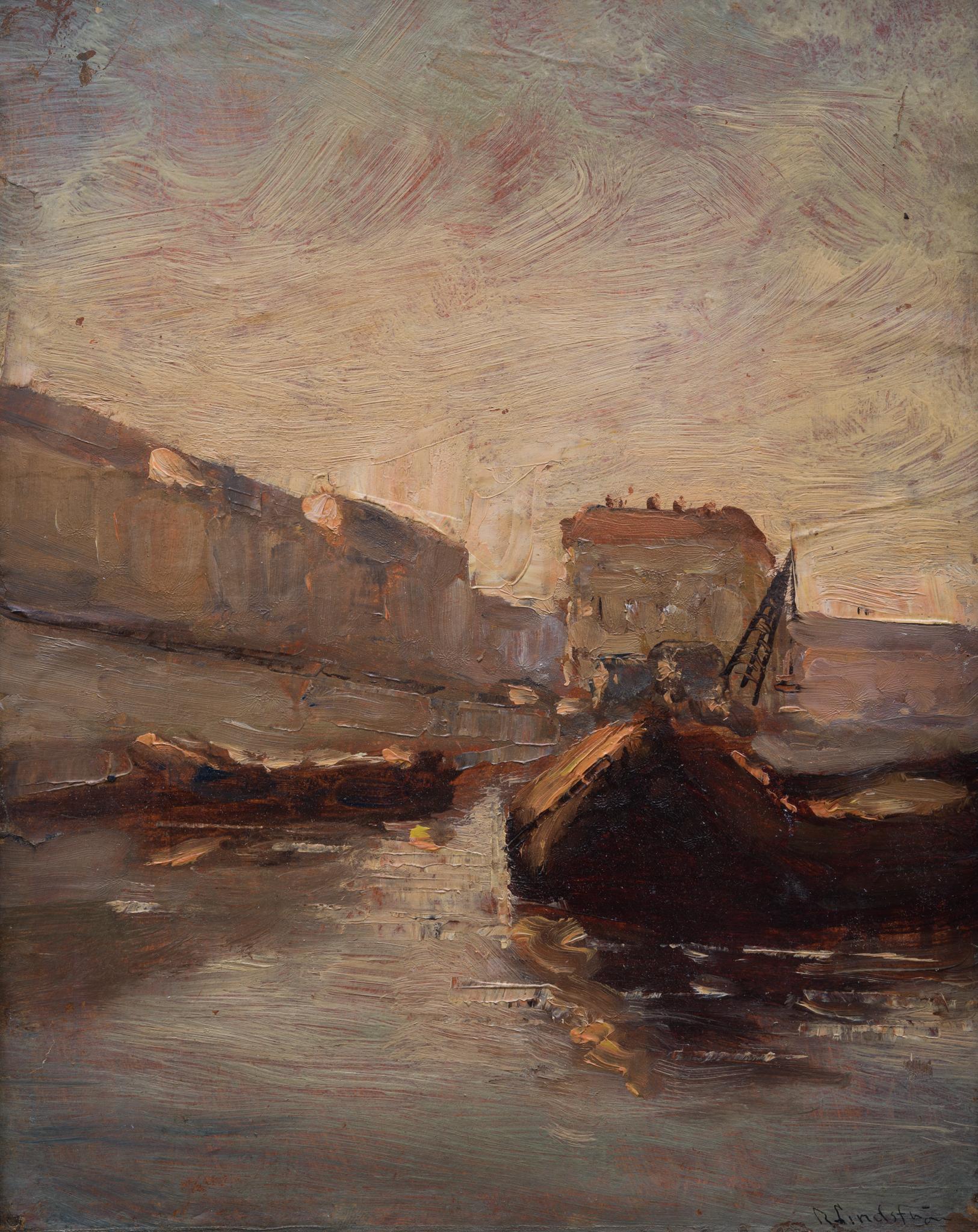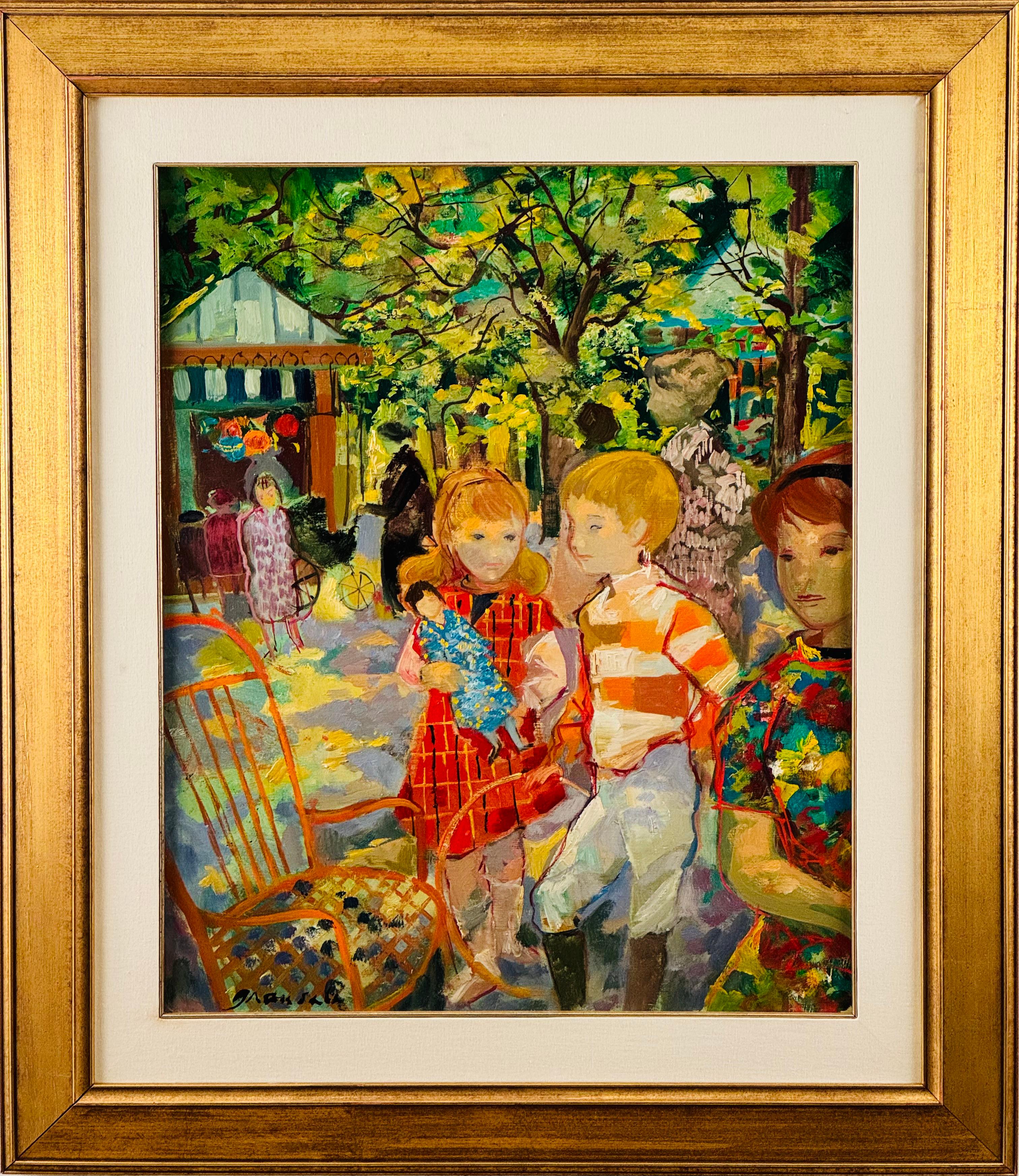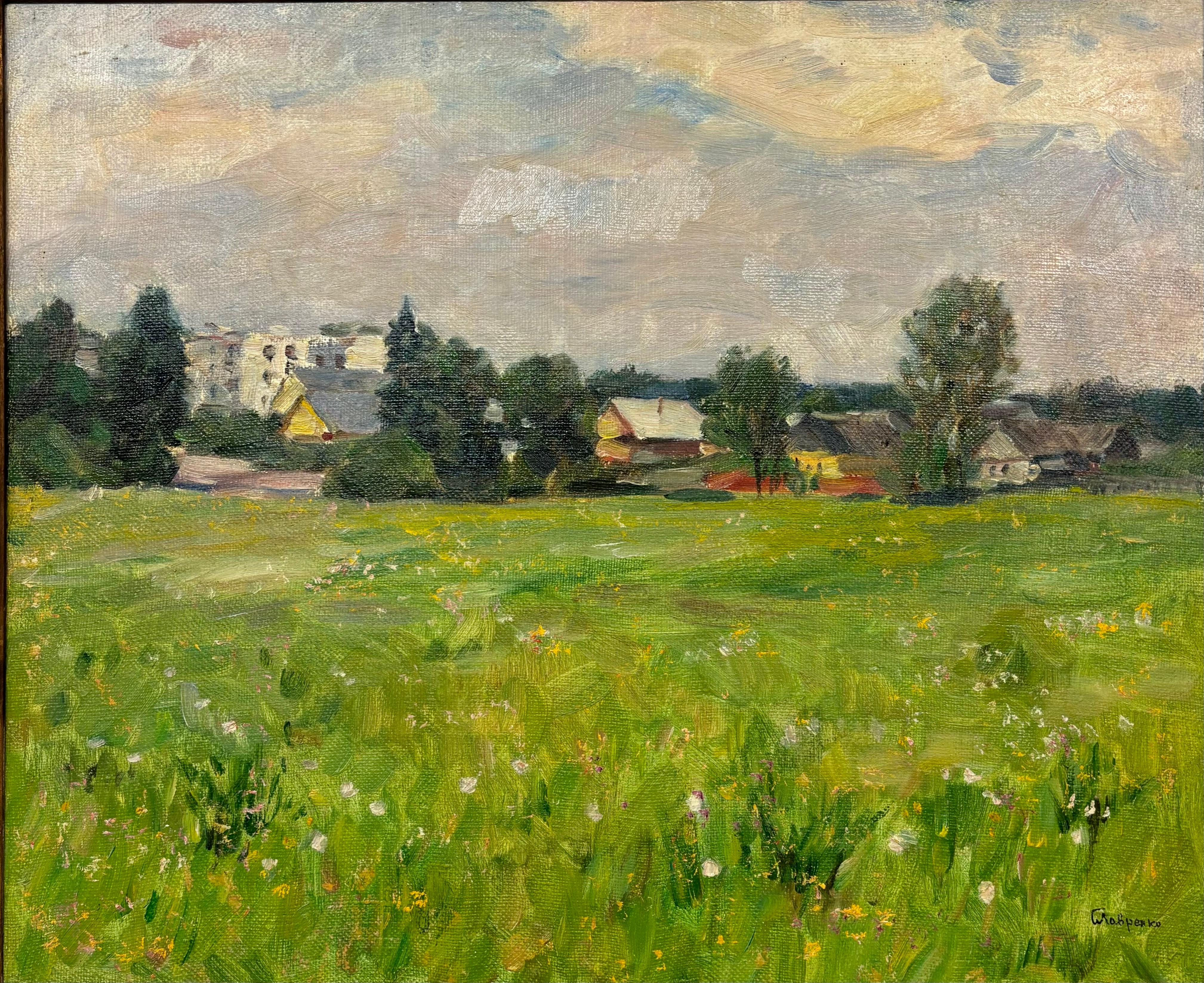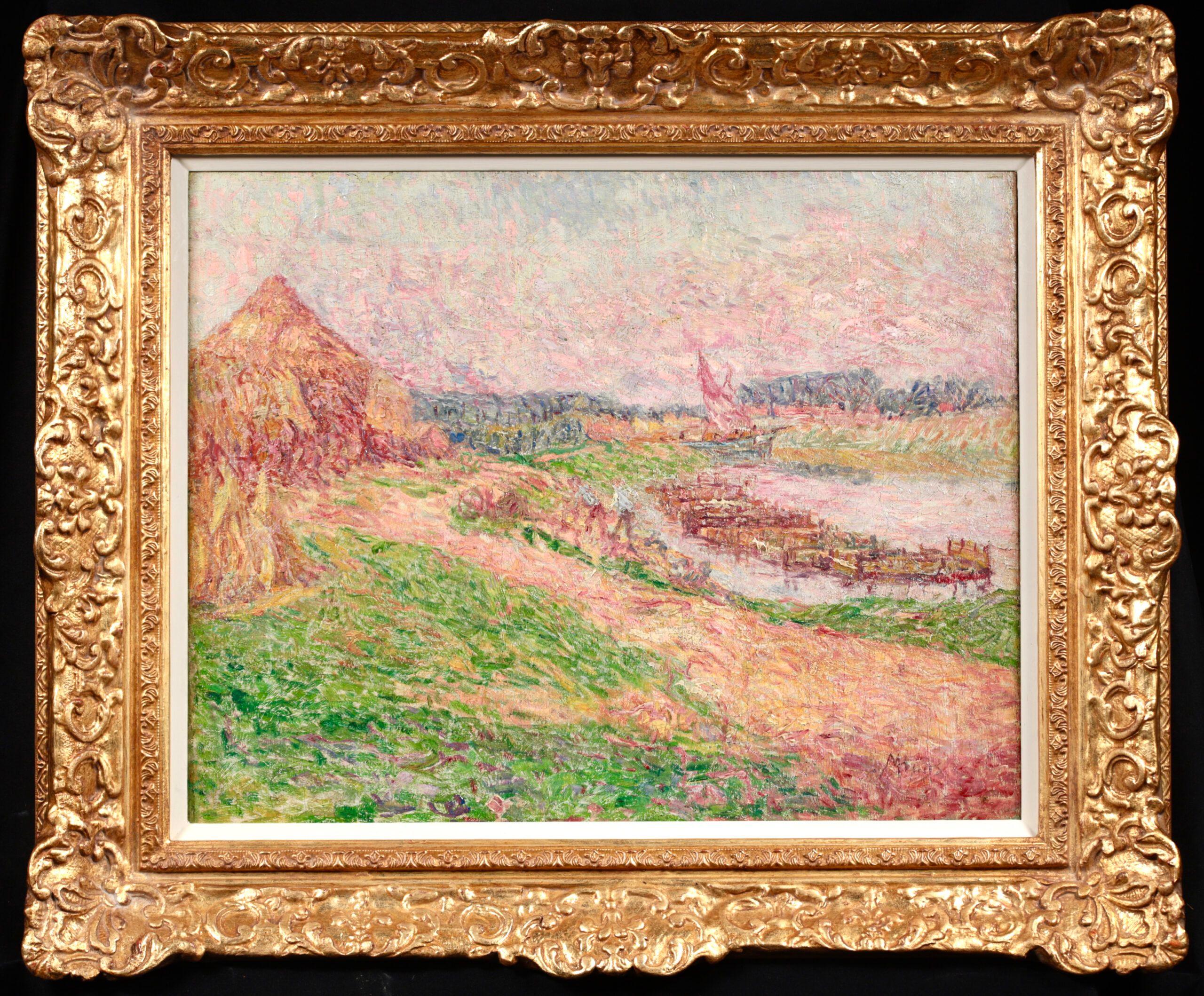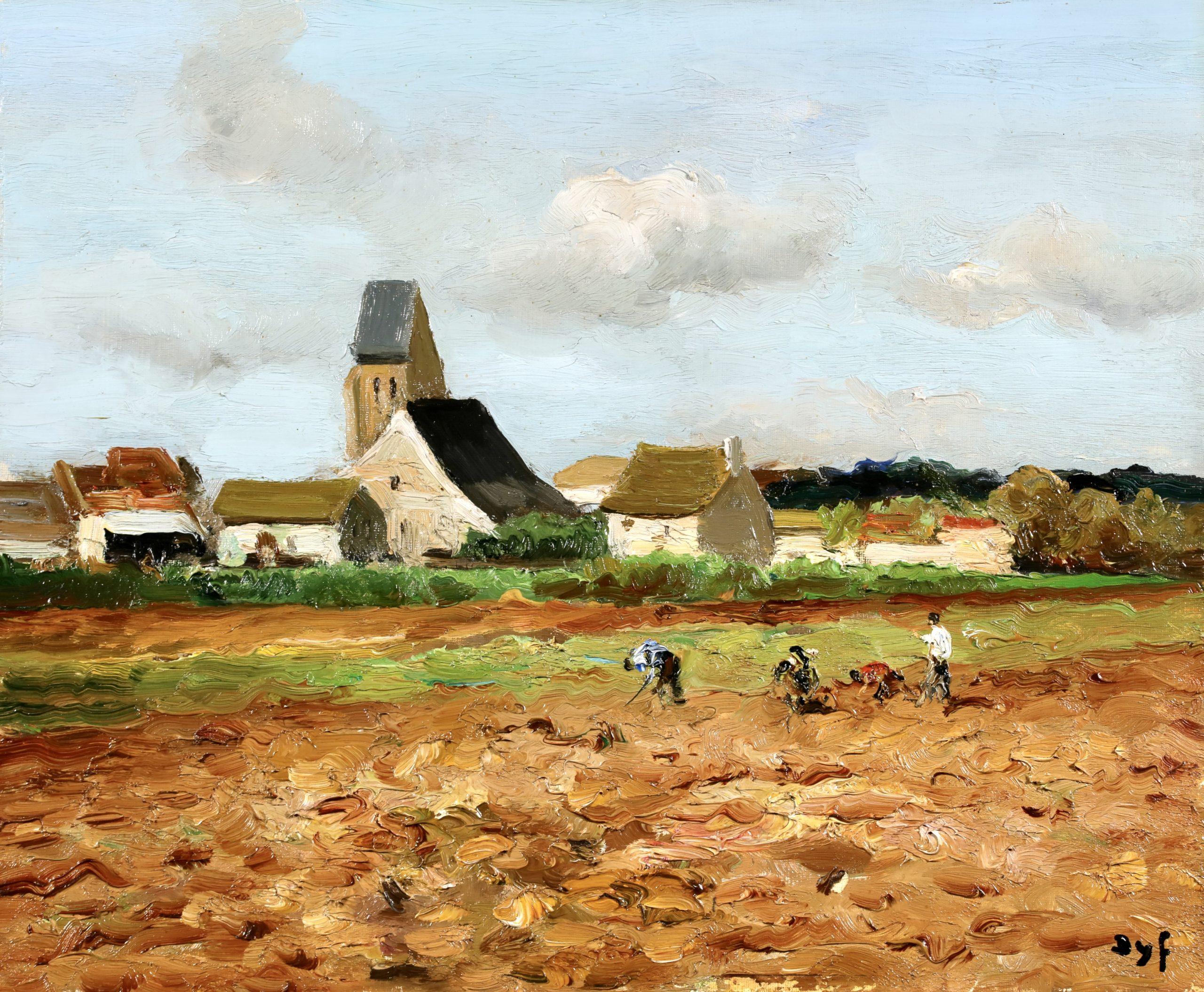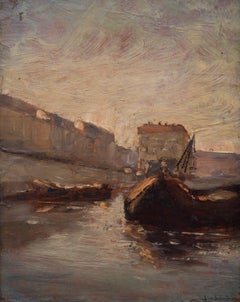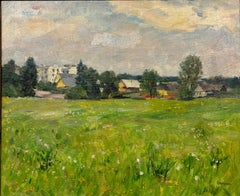Items Similar to The Steamboat - British Post Impressionist art oil painting female artist
Want more images or videos?
Request additional images or videos from the seller
1 of 17
Doris ZinkeisenThe Steamboat - British Post Impressionist art oil painting female artistCirca 1950
Circa 1950
About the Item
This superb British Post Impressionist oil painting is by noted female artist Doris Clare Zinkeisen. Painted circa 1950 the painting echoes the French Impressionists in their style and subject matter. Entitled The Steamboat, the composition is figurative landscape. The view is looking between trees to a steamboat on a river and the river landscape beyond. Several women in their long dresses and with parasols are on the river bank in front of the boat. The steamboat is already full of passengers, standing under its red and white awning. The strong light and post-Impressionist figures with their vibrant dress makes this a very charming painting by a talented female artist.
Signed lower right.
Provenance. The Fine Art Society, London Guy Reed, Copgrove Hall Guy Reed Will Trust Exhibited: London, The Fine Art Society, June 1952.
Condition. Oil on canvas, 23 inches by 18 inches and in good condition.
Frame. Housed in a light ornate frame, 30 inches by 25 inches, in good condition.
Doris Clare Zinkeisen (1898-1991) was a Scottish theatrical stage and costume designer, painter, commercial artist, and writer. She was best known for her work in theatrical design. Doris Zinkeisen was born in Clynder House in Rosneath, Argyll, Scotland. Her parents were Welsh-born Clare Bolton-Charles and Victor Zinkeisen, a timber merchant and amateur artist from Glasgow. Her father's family were originally from Bohemia and had been settled in Scotland for two hundred years. She had a younger sister, Anna Zinkeisen, who also became an artist. The family left Scotland and moved to Pinner, near Harrow in 1909. Zinkeisen attended the Harrow School of Art for four years and won a scholarship to the Royal Academy Schools in 1917 together with her sister Anna. During World War I Zinkeisen served as a Voluntary Aid Detachment at a hospital in Northwood, Middlesex.Zinkeisen shared a studio in London with her sister during the 1920s and 1930s from where she embarked on her career as a painter, commercial artist, and theatrical designer.Zinkeisen's realist style made her popular as a portraitist and she became a well-known society painter. The subject matter of her paintings, society portraiture, equestrian portraiture, and scenes from the parks of London and Paris reflect the lifestyle of the upper class at the time. An early success was her 1925 portrait of the actor Elsa Lanchester.She also worked widely in other media as an illustrator and commercial artist including producing advertising posters for several British mainline railway companies and murals for the RMS Queen Mary. A 1939 poster for the London Underground, At the Theatre, was printed but never issued due to the start of World War II. In 1944, Doris and her sister Anna were commissioned by United Steel Companies (USC) to produce twelve paintings that were reproduced in the trade and technical press in Britain, Canada, Australia and South Africa. The images were subsequently collated in a book, This Present Age, published in 1946. Zinkeisen produced a number of posters for London and North Eastern Railway (LNER), Southern Railway (SR), and the London, Midland and Scottish Railway (LMS) in the 1930s. The posters often featured historical themes such as Berwick-upon-Tweed by LNER (1930) which shows Isabella MacDuff, Countess of Buchan being punished by Edward I for crowning Robert the Bruce at Scone in 1306. In 1935, John Brown and Company Shipbuilders of Clydebank commissioned both of the Zinkeisen sisters to paint the murals in the Verandah Grill, a restaurant and night-club on the ocean liner the RMS Queen Mary. The murals, on the theme of entertainment, depicted circus and theatre scenes and can still be seen on the ship, now permanently moored in Long Beach, California. Zinkeisen was also involved in planning the interior decoration which featured a parquet dance floor surrounded by black Wilton carpets, star-studded red velvet curtains and a sweeping illuminated balustrade whose colours changed in time with the music. Writing in Vogue in 1936, Cecil Beaton described the Verandah Grill as By far the prettiest room on any ship – becomingly lit, gay in colour and obviously so successful that it would be crowded if twice its present size. The largest mural was damaged during World War II by gunnery officers tacking charts to the poster board covering the mural. After the war, Zinkeisen restored the mural and reportedly painted a mouse in the mural so there would always be a mouse on the Queen Mary, a dig at Cunard, which prided itself on having no rodents on their ships. Both sisters also contributed murals to the RMS Queen Elizabeth in 1940. Zinkeisen exhibited at the Royal Academy in 1929, at the Royal Society of Portrait Painters in London and in Paris and the United States. She received Bronze (1929), Silver (1930) and Gold (1934) Paris Salon medals for her work. By 1929 she had been elected a member of the Royal Institute of Oil Painters (ROI). Zinkeisen was a successful stage and costume designer for plays and films. Despite her success as a painter and commercial artist she was best known as a theatrical designer. During World War II, Zinkeisen joined the St John Ambulance Brigade and worked as a nurse in London helping wartime Blitz casualties having first trained as a Voluntary Aid Detachment (VAD) nurse during World War I. She worked in the casualty department in St Mary's Hospital, Paddington. Zinkeisen worked in the casualty department in the mornings and painted in the afternoons, recording the events of the day. Following the liberation of Europe in 1945, Zinkeisen was commissioned by the War Artists' Advisory Committee as a war artist for the North West Europe Commission of the Joint War Organisation of the British Red Cross Society and the Order of St John (JWO). As the organisation's staff and resources moved into newly liberated areas, Zinkeisen's role as a war artist was to record the commission's activities. Based in Brussels at the commission's headquarters she recorded the commission's post-war relief work in north west Europe including the rehabilitation and repatriation of prisoners of war and civilian internees. Zinkeisen traveled by lorry or by air (from a nearby RAF base) throughout north-west Europe making sketches which she brought back to her studio in the commission's headquarters for further work. Her work as a war artist included three days at the Bergen-Belsen concentration camp in April 1945, immediately after its liberation. Zinkeisen was one of a small number of artists who produced pictures of Bergen-Belsen in the months following its liberation. The other artists there included Leslie Cole, Mary Kessell, Sergeant Eric Taylor (one of the camp's liberators), Edgar Ainsworth, and Mervyn Peake. Her painting Human Laundry shows German orderlies washing camp inmates before they go to hospital. By the time Zinkeisen had become a war artist her palette had already darkened from the colours of her society paintings. Her war paintings use muted greys, browns, and ochres like contemporaries such as Eric Ravilious and Stanley Spencer Paintings from Zinkeisen's time as a war artist are held by the Red Cross museum and archives, the museum of the Order of St John and the Imperial War Museum. Her work was part of the painting event in the art competition at the 1948 Summer Olympics. After the war, Zinkeisen continued to work in London as a theatrical designer and held occasional exhibitions of her paintings. She designed the cover of a special edition of Everybody's Magazine to celebrate the coronation of Queen Elizabeth II in June 1953. In 1954, Zinkeisen designed the scenery and costumes for Noël Coward's musical, After the Ball, based on Oscar Wilde's play, Lady Windermere's Fan, and the Prince Littler directed play, The Little Glass Clock, written by Hugh Mills. Zinkeisen married Edward Grahame Johnstone, a naval officer in 1927 and had twin daughters in June 1928, the children's book illustrators Janet and Anne Grahame Johnstone and a son, Murray Johnstone. Zinkeisen was a fine horsewoman and won the Moscow Cup at the International Horse Show in 1934. Grahame Johnstone died in 1946 and Zinkeisen's twin girls then lived with their mother moving with her to Suffolk in 1966. Zinkeisen outlived her daughter Janet who died in an accident in 1979. Doris Zinkeisen died on 3 January 1991, in Badingham, Suffolk, aged 92.
Exhibited: Royal Academy 9, Royal Scottish Academy 7, Glasgow Institute 1, Society of Women Artists 3, Royal Hibernian Academy 1 and Paris Salon.
- Creator:Doris Zinkeisen (1898 - 1991)
- Creation Year:Circa 1950
- Dimensions:Height: 25 in (63.5 cm)Width: 30 in (76.2 cm)Depth: 2 in (5.08 cm)
- Medium:
- Movement & Style:
- Period:
- Condition:
- Gallery Location:London, GB
- Reference Number:1stDibs: LU853115671232
About the Seller
5.0
Platinum Seller
Premium sellers with a 4.7+ rating and 24-hour response times
1stDibs seller since 2018
445 sales on 1stDibs
Typical response time: <1 hour
- ShippingRetrieving quote...Shipping from: London, United Kingdom
- Return Policy
Authenticity Guarantee
In the unlikely event there’s an issue with an item’s authenticity, contact us within 1 year for a full refund. DetailsMoney-Back Guarantee
If your item is not as described, is damaged in transit, or does not arrive, contact us within 7 days for a full refund. Details24-Hour Cancellation
You have a 24-hour grace period in which to reconsider your purchase, with no questions asked.Vetted Professional Sellers
Our world-class sellers must adhere to strict standards for service and quality, maintaining the integrity of our listings.Price-Match Guarantee
If you find that a seller listed the same item for a lower price elsewhere, we’ll match it.Trusted Global Delivery
Our best-in-class carrier network provides specialized shipping options worldwide, including custom delivery.More From This Seller
View AllFestivities Buckingham Palace - British 1950's figurative landscape oil painting
By Gerald Spencer Pryse
Located in London, GB
This superb British Post Impressionist figurative landscape oil painting is by war artist Gerald Spencer Pryse. Painted circa 1953 it depicts festivities outside Buckingham Palace, L...
Category
1950s Post-Impressionist Figurative Paintings
Materials
Oil
Town Landscape with Figures - British 1930's Post Impressionist oil painting art
Located in London, GB
This interesting British 1930's Post Impressionist town landscape oil painting is by noted Liverpool born artist Edwin Glasgow. Painted in 1936 and signed lower left, the painting wa...
Category
1930s Post-Impressionist Landscape Paintings
Materials
Oil
Madrid - Scottish 1920's Post Impressionist art Spainish street oil painting
By John Bulloch Souter
Located in London, GB
A fine large oil painting by John Bulloch Souter. This is a super evocative oil on canvas depicting a scene in Madrid and was painted in 1921. It is housed in its original gilded oak...
Category
20th Century Impressionist Figurative Paintings
Materials
Oil
Laban Demanding the Return of the Teraphim from Rachel - Dutch Old Master art
By Willem van Nieulandt II
Located in London, GB
This very busy oil on panel is a Dutch Old Master painting dating to around 1620 by artist and poet Willem van Nieulandt. It is an incredibly detailed and colourful scene composed of...
Category
17th Century Old Masters Figurative Paintings
Materials
Oil
Villagers in a Landscape - Flemish 17thC art figurative landscape oil painting
Located in London, GB
This fantastic Flemish 17th century Old Master oil painting is by Thomas Van Apshoven. It was painted circa 1650 and depicts a village with figures outside a tavern, eating, drinking and dancing. Beyond are more dwellings, villagers and animals, all under a blue summer's sky. The detail, brushwork and vibrant colouring are superb. This is an excellent example of Apshoven's work and a typical subject he loved to paint.
Provenance. Leominster estate.
Wax stamp verso.
Condition. Oil on panel, 22 inches by 17 inches and in good condition.
Frame. Housed In beautiful gilt frame, 30 inches by 25 inches and in good condition.
Thomas van Apshoven (1622– 1664) was a Flemish painter known for his landscapes with peasant scenes and genre scenes in interiors. His genre scenes depict village festivals, the interiors of taverns, village scenes or landscapes with peasants engaged in various activities, singeries, guardroom scenes and laboratories of alchemists. Some still lifes have also been attributed to him. His themes and style are close to that of David Teniers the Younger. He was born on 30 November 1622 in Antwerp as the eldest son of Ferdinand van Apshoven the Elder and Leonora Wijns. His father was a painter who had studied with Adam van Noort and had become a master of the Antwerp Guild of Saint Luke in 1596. No paintings by his father are known. His younger brother Ferdinand van Apshoven the Younger became also a successful painter. Thomas studied under his father. Some sources state that he became a pupil of the prominent genre painter David Teniers the Younger. It is more likely, however, that he was an imitator of Teniers. He was registered as a 'wijnmeester' [son of a master] in the Guild of St. Luke of Antwerp in the guild year 1645–1646. He married Barbara Janssens on 22 March 1645. The couple had four children. The godfathers of the children included the painters Victor Wolfvoet...
Category
1650s Old Masters Figurative Paintings
Materials
Oil
Travellers and Dogs in Landscape, Ruins on Right - Dutch Old Master oil painting
By Pieter Wouwerman
Located in London, GB
This lovely Dutch Old Master oil painting is attributed to artist Pieter Wouwerman. Painted circa 1660 it is figurative landscape with horseback travellers and their dogs in the foreground with ruins on their right. Beyond is a river and hilly landscape, all in the fading light of approaching dusk. There are some superb details making this an excellent Dutch Golden Age oil painting.
Provenance: Devonshire estate.
Condition. Oil on canvas, 24 inches by 20 inches and in good condition.
Frame. Housed in a complementary gilt frame, 31 inches by 27 inches and in good condition.
Pieter Wouwerman (1623-1682) was a Dutch Golden Age landscape painter. He was born in Haarlem. According to Arnold Houbraken, a biographer of artists from the Dutch Golden Age, Pieter Wouwerman was the brother of the landscape painters Jan and Philips Wouwerman, who, like his more famous brother, made a living selling Italianate landscapes in the manner of Pieter van Laer...
Category
Mid-17th Century Old Masters Landscape Paintings
Materials
Oil
$17,381 Sale Price
20% Off
You May Also Like
Carlos Nadal, Pont de Ville
By Carlos Nadal
Located in Madrid, ES
CARLOS NADAL
Spanish, 1917 - 1998
PONT DE VILLE
signed "Nadal" (lower right)
titled, signed and dated "PONT DE VILLE / Nadal / 1981" (on the reverse)
with the atelier stamp (on the r...
Category
1980s Fauvist Landscape Paintings
Materials
Oil, Canvas
Canal Scene, Possibly Paris. Painted Early 1900s
Located in Stockholm, SE
For sale is a captivating painting by the Swedish artist, Rikard Lindström (1882-1943). Depicting a picturesque water canal, with charming houses lini...
Category
Early 1900s Post-Impressionist Landscape Paintings
Materials
Oil, Laid Paper
Rond-Point des Champs-Élysées
By Emilio Grau Sala
Located in Madrid, ES
EMILIO GRAU SALA
Spanish, 1911 - 1975
ROND-POINT DES CHAMPS-ÉLYSÉES
signed "Grau Sala" (lower left)
signed, located and dated "GRAU SALA / PARIS 1967" (on the reverse)
oil on canvas
...
Category
1960s Post-Impressionist Figurative Paintings
Materials
Canvas, Oil
"Paesaggio" Olio su tela cm. 60 x 52 1990
By Boris Mikhailovich Lavrenko
Located in Torino, IT
Luminoso paesggio primaverile
Boris Lavrenko (Rostov, 1920 – St. Petersburg, 2001)
Works by Boris Lavrenko can be found in various private collections in Europe, Japan, United Stat...
Category
1990s Post-Impressionist Landscape Paintings
Materials
Canvas, Oil
$3,528 Sale Price
20% Off
Free Shipping
Loading Flax on the Barges - Post Impressionist Landscape Oil by Modest Huys
Located in Marlow, Buckinghamshire
Signed divisionist landscape oil on canvas by Belgian post impressionist painter Modest Huys. This stunning piece depicts workers on the bank of a river loading flax onto barges.
Signature:
Signed lower right
Dimensions:
Framed: 23"x27"
Unframed: 15"x19"
Provenance:
Private collection - Belgium
Modest Huys (25 October 1874, in Zulte – 30 January 1932, in Zulte) was a Flemish impressionist and luminist painter, who is regarded as one of the greatest Belgian painters of the 20th century.
From a young age, Modest Huys worked in his father's painting and decorating business and later studied at the "Gentse Nijverheidschool" (Ghent Industrial School). In 1891 or 1892, he came into contact with Emile Claus, who encouraged his artistic inclinations. In 1900, he enrolled at the Royal Academy of Fine Arts where his teachers were Eugène Joors and Frans Van Leemputten but he never completed his studies. It was about this time that he became lifelong friends with the author Stijn Streuvels.
In 1902, he debuted at the Sint-Lucasgilde in Kortrijk and began to exhibit more widely. He spent time in Meetjesland, painting landscapes. From 1905, he participated in the exhibitions of Vie et Lumière...
Category
Early 1900s Post-Impressionist Landscape Paintings
Materials
Canvas, Oil
Paysans devant le village - Post Impressionist Landscape Oil by Marcel Dyf
By Marcel Dyf
Located in Marlow, Buckinghamshire
Signed oil on canvas figures in landscape circa 1950 by French post impressionist painter Marcel Dyf. The work depicts workers tending to a field beside a rural village.
Signature:
...
Category
1950s Post-Impressionist Landscape Paintings
Materials
Canvas, Oil
Recently Viewed
View AllMore Ways To Browse
Damaged Art
Doris Brown
Canadian War Poster
Velvet Framed Art
Vintage Canadian War Posters
Used Stage Floor
Gay Vintage Art
British Officer
Prince Charles Art
Three Sisters Vintage
Art In The Park Poster
The Little Prince
Ocean Liner Art
Bank Posters
French Ball Scene
Dior Plan Paris
War Ball
Australian Female Artists
